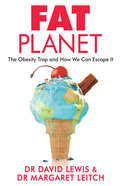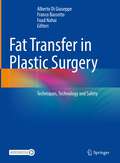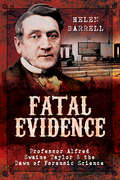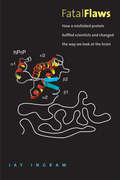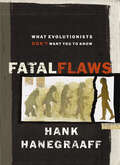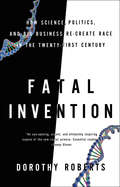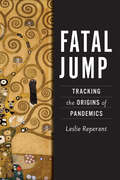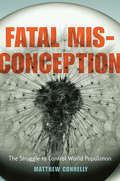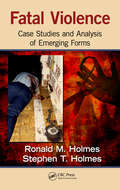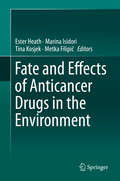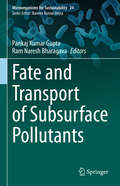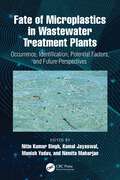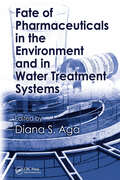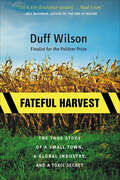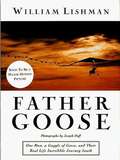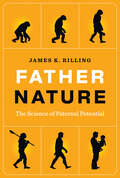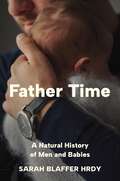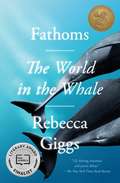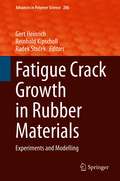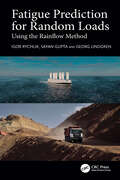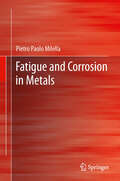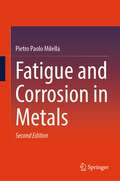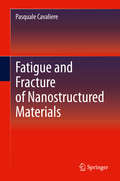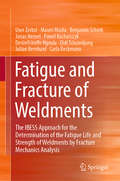- Table View
- List View
Fat Planet: The Obesity Trap and How We Can Escape It
by Dr David Lewis Dr Margaret LeitchOur planet is in the grip of an obesity pandemic.More than a billion people worldwide are overweight and over 600 million are obese. We live in an obesogenic environment in which it is much easier to get fat than to stay fit. How has this come to be? Who is to blame? What can we do?In Fat Planet, Dr David Lewis and Dr Margaret Leitch examine the social and psychological causes of the obesity pandemic in order to answer these questions. They use ground-breaking research to highlight the behaviour of corporations that relentlessly promote foods high in sugar, fat and salt, and show that these ‘junk’ foods have shockingly similar neurological effects to hard drugs. They consider the prevalence of food cues which unconsciously stimulate our desire to consume. And they debunk the myths of fad diets and slimming pills, suggesting practical, easily implemented strategies for sustainable weight loss.The evidence is clear: our problem with obesity must be addressed or we will face catastrophic consequences. It is not too late to change.
Fat Transfer in Plastic Surgery: Techniques, Technology and Safety
by Alberto Di Giuseppe Franco Bassetto Foad NahaiOnly in recent years new available technologies, the redefinition and refining of intervention techniques, and clinical research studies have widened the spectrum of fat applications in aesthetic and reconstructive surgery. Fat grafting is nowadays one of the most used techniques in plastic reconstructive surgery, as primary method or as an ancillary procedure. The optimized ratio of fat survival has led to standardized techniques followed by most practitioners.The aim of this book is to present up-to-date technologies used for fat extraction, and fat harvesting: latest tools are evaluated examining pros and cons. All recent techniques in aesthetic and reconstructive surgery and their outcomes are described in a clear, comprehensive manner; chapters present the latest research results in stem cell and regenerative medicine, their application to plastic and reconstructive surgery, in particular for hand surgery, ulcer, and capsule contractures in post breast augmentation procedures. Related specific techniques as breast fat transfer, breast hybrid implant, fat transfer and buttock fat transfer are also discussed. Safety issues in fat transfer procedures are examined accurately, particularly those involving buttock fat transfer. Each procedure is completed by a scientific analysis of the main reasons for complications, how to prevent them and the safety guidelines recommended as golden standard to be followed. The surgical part contains clinical cases related to each chapter topic, videos, and all chapters have a box with take home messages. An invaluable tool for correct decision-making for clinicians, fellows and residents in plastic surgery, Fat Transfer in Plastic Surgery focuses on indications, applications and surgical techniques for each individual body district, and safe and reliable procedures in the application of latest technology. district, and safe and reliable procedures in the application of latest technology. district, and safe and reliable procedures in the application of latest technology. district, and safe and reliable procedures in the application of latest technology. district, and safe and reliable procedures in the application of latest technology. district, and safe and reliable procedures in the application of latest technology. district, and safe and reliable procedures in the application of latest technology. district, and safe and reliable procedures in the application of latest technology. district, and safe and reliable procedures in the application of latest technology. district, and safe and reliable procedures in the application of latest technology.
Fatal Evidence: Professor Alfred Swaine Taylor & the Dawn of Forensic Science
by Helen Barrell&“An engrossing read . . . Her description of the ways in which forensic experiments evolved is as fascinating as the courtroom dramas they accompanied.&” —Jess Kidd, The Guardian, &“Best Summer Books 2018, as Picked by Writers&” A surgeon and chemist at Guys Hospital in London, Professor Alfred Swaine Taylor used new techniques to search the human body for evidence that once had been unseen. As well as tracing poisons, he could identify blood on clothing and weapons, and used hair and fiber analysis to catch killers. Taylor is perhaps best remembered as an expert witness at one of Victorian England&’s most infamous trials—that of William Palmer, &“The Rugeley Poisoner.&” But he was involved in many other intriguing cases, from a skeleton in a carpet bag to a fire that nearly destroyed two towns, and several poisonings in between. Taylor wrote widely on forensic medicine. He gave Charles Dickens a tour of his laboratory, and Wilkie Collins owned copies of his books. His work was known to Sir Arthur Conan Doyle, and he inspired the creation of fictional forensic detective Dr. Thorndyke. For Dorothy L. Sayers, Taylors books were the back doors to death. From crime scene to laboratory to courtroom and sometimes to the gallows, this is the world of Professor Alfred Swaine Taylor and his fatal evidence. &“A must read for any lover of crime writing, criminology, and Victorian cultural history.&” —Fortean Times &“Totally fascinating . . . Refers to many famous and not-so-famous cases, as well as giving an insight into this clever, enthusiastic, honourable and dedicated man. Very clearly written and very enjoyable read.&” —Michelle Birkby, author of The Baker Street Inquiries series
Fatal Flaws: How a Misfolded Protein Baffled Scientists and Changed the Way We Look at the Brain
by Jay IngramFrom the bestselling author of The Science of Why series, &“a &‘whodunit&’ about one of the most fascinating and improbable tales of medical discovery&” (Jonathan A. Edlow, MD, author of The Deadly Dinner Party:And Other Medical Detective Stories). Discovered and identified as the cause of mad cow disease only three decades ago, the prion is a protein molecule that, when misshapen in the brain, becomes fatal. Novel and controversial, prions have provoked a scientific revolution. They challenge the very foundations of biology: A disease-causing entity with no genetic material at all? A molecule capable of infecting, multiplying, and killing? This book recounts the birth of prion science and the imaginative detective work scientists have undertaken as they struggle to find the answers to devastating brain diseases from mad cow and Creutzfeldt-Jakob disease to Parkinson&’s, Alzheimer&’s, Lou Gehrig&’s, and others. As in each of his bestselling books, Jay Ingram here makes complex scientific concepts accessible and shows how little-known events may have profound significance. He describes the development of prion science as a rough-and-tumble affair, with rivals, eccentrics, interfering governments, and brilliantly creative people all playing salient roles. Weaving biology, medicine, human tragedy, discovery, and bitter scientific competition into his account, he reveals the stunning potential of prion science, whose discoveries may unlock the answers to some of humankind&’s most destructive diseases. &“The way Ingram presents the ongoing search for answers surrounding BSE and associated neurological conditions makes for an excellent read.&”—Quill & Quire (starred review) &“Provides a fascinating insight into the twists and turns of this new science.&”—Lara V. Marks, author of Sexual Chemistry: A History of the Contraceptive Pill
Fatal Flaws: What Evolutionists Don't Want You to Know
by Hank HanegraaffAs more and more so-called experts challenge what the Bible says about the creation of man, we must take aim with straightforward, Christ-centered answers. Today's generation is bombarded with theories about humankind and its origins. In Fatal Flaws, now in paperback with a study guide included, Hank Hanegraaff keeps Christians from falling prey to corrupting scientific speculation about the origins of life and reminds us that we are God's creation. This common-sense approach puts the concept of evolution in the grasp of everyday Christians and reminds us that ultimately the key to our purpose in this life comes from understanding whose we are and who created us.
Fatal Invention: How Science, Politics, and Big Business Re-create Race in the Twenty-First Century
by Dorothy RobertsAn incisive, groundbreaking book that examines how a biological concept of race is a myth that promotes inequality in a supposedly &“post-racial&” era. Though the Human Genome Project proved that human beings are not naturally divided by race, the emerging fields of personalized medicine, reproductive technologies, genetic genealogy, and DNA databanks are attempting to resuscitate race as a biological category written in our genes. This groundbreaking book by legal scholar and social critic Dorothy Roberts examines how the myth of race as a biological concept—revived by purportedly cutting-edge science, race-specific drugs, genetic testing, and DNA databases—continues to undermine a just society and promote inequality in a supposedly &“post-racial&” era. Named one of the ten best black nonfiction books 2011 by AFRO.com, Fatal Invention offers a timely and &“provocative analysis&” (Nature) of race, science, and politics that &“is consistently lucid . . . alarming but not alarmist, controversial but evidential, impassioned but rational&” (Publishers Weekly, starred review). &“Everyone concerned about social justice in America should read this powerful book.&” —Anthony D. Romero, executive director, American Civil Liberties Union &“A terribly important book on how the &‘fatal invention&’ has terrifying effects in the post-genomic, &‘post-racial&’ era.&” —Eduardo Bonilla-Silva, professor of sociology, Duke University, and author of Racism Without Racists: Color-Blind Racism and the Persistence of Racial Inequality in the United States &“Fatal Invention is a triumph! Race has always been an ill-defined amalgam of medical and cultural bias, thinly overlaid with the trappings of contemporary scientific thought. And no one has peeled back the layers of assumption and deception as lucidly as Dorothy Roberts.&” —Harriet A. Washington, author of and Deadly Monopolies: The Shocking Corporate Takeover of Life Itself
Fatal Jump: Tracking the Origins of Pandemics
by Leslie ReperantExploring the fateful chains of events that gave rise to humanity's infectious diseases and pandemics.Why do global pandemics materialize? To address this question, we must delve into the world of pathogens that transcend their original host species and jump into new ones. Most pathogens fail to initiate infection or spread in the population when they jump. Only a few sustain onward chains of transmission, and even fewer sustain these indefinitely. Yet the rare pathogens that do make the leap have caused many of humanity's most dangerous infectious diseases.In Fatal Jump: Tracking the Origins of Pandemics, veterinary disease ecologist Dr. Leslie Reperant investigates mysteries such as how African-originated monkeypox left its home continent, why COVID-19 could threaten measles control, and how pigs' fondness for mangoes enabled the deadly Nipah virus to spread. She shares behind-the-scenes insights into hugely destructive pathogens carried by rats, bats, ticks, and mosquitoes, as well as lesser-known vectors such as prairie dogs and camels. Drawing from the latest research, she discusses whether we can predict these deadly jumps before they happen and what factors—including environmental change, population dynamics, and molecular evolution—enable a zoonotic disease to reach full pandemic status. Rich with recent scientific discoveries and emerging theories, this book spans a diverse range of disciplines, weaving their insights into a holistic view of infectious disease.With new pathogens emerging at an alarming pace, Fatal Jump reorients our perspective on pandemics from a human-centered standpoint to the bigger picture. We will understand what actions are necessary to control emergence only by recognizing the increasingly global nature of human society and the connections between the planet's environmental health and our own health.
Fatal Misconception: The Struggle to Control World Population
by Matthew ConnellyListen to a short interview with Matthew Connelly Host: Chris Gondek | Producer: Heron & Crane Fatal Misconception is the disturbing story of our quest to remake humanity by policing national borders and breeding better people. As the population of the world doubled once, and then again, well-meaning people concluded that only population control could preserve the "quality of life." This movement eventually spanned the globe and carried out a series of astonishing experiments, from banning Asian immigration to paying poor people to be sterilized. Supported by affluent countries, foundations, and non-governmental organizations, the population control movement experimented with ways to limit population growth. But it had to contend with the Catholic Church's ban on contraception and nationalist leaders who warned of "race suicide." The ensuing struggle caused untold suffering for those caught in the middle--particularly women and children. It culminated in the horrors of sterilization camps in India and the one-child policy in China. Matthew Connelly offers the first global history of a movement that changed how people regard their children and ultimately the face of humankind. It was the most ambitious social engineering project of the twentieth century, one that continues to alarm the global community. Though promoted as a way to lift people out of poverty--perhaps even to save the earth--family planning became a means to plan other people‘s families. With its transnational scope and exhaustive research into such archives as Planned Parenthood and the newly opened Vatican Secret Archives, Connelly's withering critique uncovers the cost inflicted by a humanitarian movement gone terribly awry and urges renewed commitment to the reproductive rights of all people.
Fatal Violence: Case Studies and Analysis of Emerging Forms
by Ronald M. Holmes Stephen T. HolmesFrom serial murderers to parents who kill, Fatal Violence: Case Studies and Analysis of Emerging Forms provides an insider‘s look at a phenomenon that has existed since the dawn of man and cuts across social/economic barriers and cultures. Offering a rare glimpse into the minds of predators and containing chilling details of motives and methods, th
Fate and Effects of Anticancer Drugs in the Environment
by Ester Heath Marina Isidori Tina Kosjek Metka FilipičThe book provides current knowledge and research on the presence and effects of anticancer drug residues in the aqueous environment and covers all relevant aspects of the presence of these residues in wastewaters and natural aquatic systems, where numerous analogies between their pharmacokinetics and pharmacodynamics in humans and their effects in the environment can be drawn. This book comprises of 18 chapters and represents the combined work of leading scientists from different research institutions from across the globe. We present the state of the art in the field of anticancer drug residues in the aquatic environment while being cognizant of the many challenges that remain.
Fate and Transport of Subsurface Pollutants (Microorganisms for Sustainability #24)
by Ram Naresh Bharagava Pankaj Kumar GuptaThis volume offers detailed information on the behaviour of various water pollutants, and on the principles and concepts of groundwater flow and transport. It will help readers to understand and execute the planning, supervision, and review of solute transport and groundwater modeling projects. The book also discusses the role and fate of elements that have been identified as major contaminants in surface and subsurface waters, and their adverse effects on ecology and human health. The book explores this theme throughout four sections – a. Understanding Soil-Water Systems, b. Fate and Transport of Pollutants, c. Physico-Chemical Treatment of Wastewater and d. Microbial Techniques Used to Decontaminate Soil-Water Systems. Introducing readers to a range of recent advances concerning the fundamentals of subsurface water treatment, it offers a valuable guide for teachers, researchers, policymakers, and undergraduate and graduate students of hydrology, environmental microbiology, biotechnology and the environmental sciences. It also provides field engineers and industrial practitioners with essential support in the effective remediation and management of polluted sites.
Fate of Microplastics in Wastewater Treatment Plants: Occurrence, Identification, Potential Factors, and Future Perspectives
by Nitin Kumar Singh Komal Jayaswal Manish Yadav Namita MaharjanThis book covers the various sources, the role of treatment technologies, system-associated factors, and future challenges with reference to microplastics in wastewater treatment plants. It also introduces microplastics, their sources, governing factors, microbial diversity effects, and possible control approaches to minimize the exposure of microplastics to human beings. Modelling and distribution of microplastics, environmental sinks, bioindicators, and microplastics as vector in wastewater treatment units are also discussed. Focuses on microplastic pollution, mechanism of removal, treatment technologies, pathways, and fate in wastewater treatment system Discusses the factors linked to dispersion, survival, and removal efficiency of microplastics in wastewater treatment systems Helps understand ‘microplastics removal’-centric sustainability aspects of wastewater treatment systems Explores the fate of microplastics in sludge-handling systems Incorporates comparative case studies from developed and developing nations This book is aimed at graduate students and researchers in environmental science and engineering, water resources management, wastewater, and chemical engineering.
Fate of Pharmaceuticals in the Environment and in Water Treatment Systems
by Diana S. AgaThe detection of pharmaceutical residues remained elusive until instruments such as liquid chromatography and mass spectrometry became commonplace in environmental laboratories. The documentation of the occurrence of pharmaceutical residues and endocrine disrupting chemicals in water resources has raused questions about their long-term effects
Fateful Harvest: The True Story of a Small Town, a Global Industry, and a Toxic Secret
by Duff WilsonI see soil in a new light, and I wonder about my own lawn and garden. What have I sprinkled on my backyard? Is somebody using my home, my food, to recycle toxic waste? It seems unbelievable, outlandish -- but what if it's true?A riveting expose, Fateful Harvest tells the story of Patty Martin -- the mayor of a small Washington town called Quincy -- who discovers American industries are dumping toxic waste into farmers' fields and home gardens by labeling it "fertilizer." She becomes outraged at the failed crops, sick horses, and rare diseases in her town, as well as the threats to her children's health. Yet, when she blows the whistle on a nationwide problem, Patty Martin is nearly run out of town.Duff Wilson, whose Seattle Times series on this story was a finalist for the Pulitzer Prize, provides the definitive account of a new and alarming environmental scandal. Fateful Harvest is a gripping study of corruption and courage, of recklessness and reckoning. It is a story that speaks to the greatest fears -- and ultimate hope -- in us all.
Father Goose: One Man, a Gaggle of Geese and Their Real Life Incredible Journey South
by William Lishman Joseph DuffFeatured on an enormously popular 20/20 segment, this heartwarming story tells of William Lishman, a reclusive sculptor, who adopted a gaggle of geese, flew with them in an ultralight glider, and actually taught them to migrate--earning himself the nickname "Father Goose. "
Father Nature: The Science of Paternal Potential
by James K. RillingHow and why human males evolved the capacity to be highly involved caregivers—and why some are more involved than others.We all know the importance of mothers. They are typically as paramount in the wild as they are in human relationships. But what about fathers? In most mammals, including our closest living primate relatives, fathers have little to no involvement in raising their offspring—and sometimes even kill the offspring sired by other fathers. How, then, can we explain modern fathers having the capacity to be highly engaged parents? In Father Nature, James Rilling explores how humans have evolved to endow modern fathers with this potential and considers why this capacity evolved in humans.Paternal caregiving is advantageous to children and, by extension, to society at large, yet variable both across and within human societies. Rilling considers how to explain this variability and what social and policy changes might be implemented to increase positive paternal involvement. Along the way, Father Nature also covers the impact fathers have on children&’s development, the evolution of paternal caregiving, how natural selection adapted male physiology for caregiving, and finally, what lessons an expecting father can take away from the book, as well as what benefits they themselves get from raising children, including increased longevity and &“younger&” brains.A beautifully written book by a father himself, Father Nature is a much-needed—and deeply rewarding—look at the science behind &“good&” paternal behavior in humans.
Father Time: A Natural History of Men and Babies
by Sarah Blaffer HrdyA sweeping account of male nurturing, explaining how and why men are biologically transformed when they care for babies It has long seemed self-evident that women care for babies and men do other things. Hasn&’t it always been so? When evolutionary science came along, it rubber-stamped this venerable division of labor: mammalian males evolved to compete for status and mates, while females were purpose-built to gestate, suckle, and otherwise nurture the victors&’ offspring. But come the twenty-first century, increasing numbers of men are tending babies, sometimes right from birth. How can this be happening? Puzzled and dazzled by the tender expertise of new fathers around the world—several in her own family—celebrated evolutionary anthropologist and primatologist Sarah Blaffer Hrdy set out to trace the deep history of male nurturing and explain a surprising departure from everything she had assumed to be &“normal.&”In Father Time, Hrdy draws on a wealth of research to argue that this ongoing transformation in men is not only cultural, but profoundly biological. Men in prolonged intimate contact with babies exhibit responses nearly identical to those in the bodies and brains of mothers. They develop caring potential few realized men possessed. In her quest to explain how men came to nurture babies, Hrdy travels back through millions of years of human, primate, and mammalian evolution, then back further still to the earliest vertebrates—all while taking into account recent economic and social trends and technological innovations and incorporating new findings from neuroscience, genetics, endocrinology, and more. The result is a masterful synthesis of evolutionary and historical perspectives that expands our understanding of what it means to be a man—and what the implications might be for society and our species.
Fathoming the Ocean: The Discovery and Exploration of the Deep Sea
by Helen M Rozwadowski&“[An] amiable, in-depth examination of the most critical era for the development of modern oceanography&” (Publishers Weekly). In a history at once scientific and cultural, Helen Rozwadowski shows us how the Western imagination awoke to the ocean's possibilities?in maritime novels, in the popular hobby of marine biology, in the youthful sport of yachting, and in the laying of a trans-Atlantic telegraph cable. The ocean emerged as important new territory, and scientific interests intersected with those of merchant-industrialists and politicians. Rozwadowski documents the popular crazes that coincided with these interests?from children's sailor suits to the home aquarium and the surge in ocean travel. She describes how, beginning in the 1860s, oceanography moved from yachts onto the decks of oceangoing vessels, and landlubber naturalists found themselves navigating the routines of a working ship's physical and social structures.Fathoming the Ocean offers a rare and engaging look into our fascination with the deep sea and into the origins of oceanography?origins still visible in a science that focuses the efforts of physicists, chemists, geologists, biologists, and engineers on the common enterprise of understanding a vast, three-dimensional, alien space. &“Rozwadowski greatly expands our own understanding, all while telling a story that is original, wide-ranging, and illuminating.&” —Margaret Deacon, Southampton Oceanography Centre, author of Science and the Sea: The Origins of Oceanography &“Required reading for anyone wanting to understand how the oceans have come to play the role that they do in Western knowledge.&” —Eric L. Mills, Dalhousie University and author of Biological Oceanography: An Early History, 1870-1960 &“Chronicles the birth of deep-sea oceanography, from early observations by Benjamin Franklin to the voyage of HMS Challenger in the 1870s. [Rozwadowski] weaves a rich narrative from the world of renowned as well as lesser-known oceanographers.&” —Nature
Fathoms: The World in the Whale
by Rebecca GiggsWinner of the 2021 Andrew Carnegie Medal for Excellence in Nonfiction * Finalist for the 2020 Kirkus Prize for Nonfiction * Finalist for the PEN/E.O. Wilson Literary Science Writing Award A &“delving, haunted, and poetic debut&” (The New York Times Book Review) about the awe-inspiring lives of whales, revealing what they can teach us about ourselves, our planet, and our relationship with other species. When writer Rebecca Giggs encountered a humpback whale stranded on her local beachfront in Australia, she began to wonder how the lives of whales reflect the condition of our oceans. Fathoms: The World in the Whale is &“a work of bright and careful genius&” (Robert Moor, New York Times bestselling author of On Trails), one that blends natural history, philosophy, and science to explore: How do whales experience ecological change? How has whale culture been both understood and changed by human technology? What can observing whales teach us about the complexity, splendor, and fragility of life on earth? In Fathoms, we learn about whales so rare they have never been named, whale songs that sweep across hemispheres in annual waves of popularity, and whales that have modified the chemical composition of our planet&’s atmosphere. We travel to Japan to board the ships that hunt whales and delve into the deepest seas to discover how plastic pollution pervades our earth&’s undersea environment. With the immediacy of Rachel Carson and the lush prose of Annie Dillard, Giggs gives us a &“masterly&” (The New Yorker) exploration of the natural world even as she addresses what it means to write about nature at a time of environmental crisis. With depth and clarity, she outlines the challenges we face as we attempt to understand the perspectives of other living beings, and our own place on an evolving planet. Evocative and inspiring, Fathoms &“immediately earns its place in the pantheon of classics of the new golden age of environmental writing&” (Literary Hub).
Fatigue Crack Growth in Rubber Materials: Experiments and Modelling (Advances in Polymer Science #286)
by Gert Heinrich Reinhold Kipscholl Radek StočekThe book summarizes recent international research and experimental developments regarding fatigue crack growth investigations of rubber materials. It shows the progress in fundamental as well as advanced research of fracture investigation of rubber material under fatigue loading conditions, especially from the experimental point of view. However, some chapters will describe the progress in numerical modeling and physical description of fracture mechanics and cavitation phenomena in rubbers. Initiation and propagation of cracks in rubber materials are dominant phenomena which determine the lifetime of these soft rubber materials and, as a consequence, the lifetime of the corresponding final rubber parts in various fields of application. Recently, these phenomena became of great scientific interest due to the development of new experimental methods, concepts and models. Furthermore, crack phenomena have an extraordinary impact on rubber wear and abrasion of automotive tires; and understanding of crack initiation and growth in rubbers will help to support the growthing number of activities and worldwide efforts of reduction of tire wear losses and abrasion based emissions.
Fatigue Prediction for Random Loads: Using the Rainflow Method
by Georg Lindgren Igor Rychlik Sayan GuptaFatigue Prediction for Random Loads serves as a comprehensive treatise for methods for fatigue estimation and fatigue life prediction in randomly excited structural systems using the rainflow cycle counting method.Fatigue is an important mode of material degradation in structural components subjected to vibrations and a reliable estimation of their fatigue life span, and it is a key consideration in the design and development of such systems. This book uses advanced concepts of probability theory, random variables and random processes to develop spectral-based methods and formulae for predicting expected fatigue damage and expected fatigue life. The developments presented here bypass the need for a computationally expensive rainflow cycle counting that is usually adopted in time domain approaches.This book is aimed towards researchers and industry practitioners working in the intersectional areas of mechanics and applied mathematics and is expected to be particularly useful for applications on problems in the fields of wind engineering, offshore engineering, ship research and routing, aerospace engineering, automotive engineering and machine dynamics.
Fatigue and Corrosion in Metals
by Pietro Paolo MilellaThis textbook, suitable for students, researchers and engineers, gathers the experience of more than 20 years of teaching fracture mechanics, fatigue and corrosion to professional engineers and running experimental tests and verifications to solve practical problems in engineering applications. As such, it is a comprehensive blend of fundamental knowledge and technical tools to address the issues of fatigue and corrosion. The book initiates with a systematic description of fatigue from a phenomenological point of view, since the early signs of submicroscopic damage in few surface grains and continues describing, step by step, how these precursors develop to become mechanically small cracks and, eventually, macrocracks whose growth is governed by fracture mechanics. But fracture mechanics is also introduced to analyze stress corrosion and corrosion assisted fatigue in a rather advanced fashion. The author dedicates a particular attention to corrosion starting with an electrochemical treatment that mechanical engineers with a rather limited knowledge of electrochemistry will well digest without any pain. The electrochemical introduction is considered an essential requirement to the full understanding of corrosion that is essentially an electrochemical process. All stress corrosion aspects are treated, from the generalized film rupture-anodic dissolution process that is the base of any corrosion mechanism to the aggression occurring in either mechanically or thermally sensitized alloys up to the universe of hydrogen embrittlement, which is described in all its possible modes of appearance. Multiaxial fatigue and out-of-phase loading conditions are treated in a rather comprehensive manner together with damage progression and accumulation that are not linear processes. Load spectra are analyzed also in the frequency domain using the Fourier transform in a rather elegant fashion full of applications that are generally not considered at all in fatigue textbooks, yet they deserve a special place and attention. The issue of fatigue cannot be treated without a probabilistic approach unless the designer accepts the shame of one-out-of-two pieces failure. The reader is fully introduced to the most promising and advanced analytical tools that do not require a normal or lognormal distribution of the experimental data, which is the most common case in fatigue. But the probabilistic approach is also used to introduce the fundamental issue of process volume that is the base of any engineering application of fatigue, from the probability of failure to the notch effect, from the metallurgical variability and size effect to the load type effect. Fractography plays a fundamental role in the post mortem analysis of fatigue and corrosion failures since it can unveil the mystery encrypted in any failure.
Fatigue and Corrosion in Metals
by Pietro Paolo MilellaWith its combination of readability, love for details and rigor, “Fatigue and Corrosion in Metals” has become an authoritative reference work that has quickly established itself as the most comprehensive guide for fatigue and corrosion design available to date. It has been adopted by several universities as reference textbook and consulted by professional engineers and scholars worldwide. This must-have Second Edition, completely revisited to account for advances in the decade since the previous edition was published, includes: · A new Chapter on damage nucleation.· A new Chapter on Very High Cycle Fatigue.· A new Chapter on fatigue testing and fatigue S-N curve determination.· Expanded analysis of surface treatments and inclusions effect on fatigue.· Expanded treatment of volume process effect on fatigue.· Expanded treatments of corrosion and hydrogen embrittlement.In addition to these enhancements, it includes a detailed treatment of· Phenomenology and morphological aspects of fatigue.· Surface treatments, conditions, and nonmetallic inclusions effects on fatigue.· Stress and strain-based fatigue analysis.· Mean stress and notch effect on fatigue.· Cumulative damage and multiaxial fatigue.· Probabilistic analysis application to fatigue design.· Fatigue in welds.· Stress corrosion and hydrogen embrittlement.· Fracture mechanics application to fatigue and corrosion. It serves as a valuable and needful information source on the desktop of anyone involved with fatigue and corrosion in metals.
Fatigue and Fracture of Nanostructured Materials
by Pasquale CavaliereThis book describes the main approaches for production and synthesis of nanostructured metals and alloys, taking into account the fatigue behavior of materials in additive manufactured components. Depending on the material type, form, and application, a deep discussion of fatigue properties and crack behavior is also provided. Pure nanostructured metals, complex alloys and composites are further considered. Prof. Cavaliere’s examination is supported by the most up-to-date understanding from the scientific literature along with a thorough presentation of theory. Bringing together the widest range of perspective on its topic, the book is ideal for materials researchers, professional engineers in industry, and students interested in nanostructured materials, fracture/fatigue mechanics, and additive manufacturing.Describes in detail the relevance of nanostructures in additive manufacturing technologies;Includes sufficient breadth and depth on theoretical modelling of fatigue and crack behavior for use in the classroom;Identifies many open questions regarding different theories through experimental finding;Contextualizes the latest scientific results for readers in industry.
Fatigue and Fracture of Weldments: The Ibess Approach For The Determination Of The Fatigue Life And Strength Of Weldments By Fracture Mechanics Analysis
by Uwe Zerbst Mauro Madia Benjamin Schork Jonas Hensel Pawel Kucharczyk DesireTchoffo Ngoula Didi Tchuindjang Julian Bernhard Carla BeckmannThis book provides a comprehensive and thorough guide to those readers who are lost in the often-confusing context of weld fatigue. It presents straightforward information on the fracture mechanics and material background of weld fatigue, starting with fatigue crack initiation and short cracks, before moving on to long cracks, crack closure, crack growth and threshold, residual stress, stress concentration, the stress intensity factor, J-integral, multiple cracks, weld geometries and defects, microstructural parameters including HAZ, and cyclic stress-strain behavior. The book treats all of these essential and mutually interacting parameters using a unique form of analysis.
